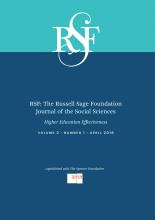Research ArticleII. Supply and Demand: Cost and Distributional Outcomes
Open Access
The Changing Landscape of Tuition and Enrollment in American Public Higher Education
Steven W. Hemelt, Dave E. Marcotte
RSF: The Russell Sage Foundation Journal of the Social Sciences April 2016, 2 (1) 42-68; DOI: https://doi.org/10.7758/RSF.2016.2.1.03
Steven W. Hemelt
aAssistant professor of public policy at the University of North Carolina at Chapel Hill
Dave E. Marcotte
bProfessor of public policy and director of the Washington Institute for Public Affairs Research at American University in Washington, D.C

REFERENCES
- ↵Abramson, Larry. 2011. “Why Does College Cost So Much?” NPR Education, October 19, 2011. Accessed December 14, 2015. http://www.npr.org/2011/10/19/141505658/why-is-college-so-expensive.
- ↵Archibald, Robert B., and David H. Feldman. 2011. Why Does College Cost So Much? New York: Oxford University Press.
- ↵
- Behrman, Jere R.,
- Mark R. Rosenzweig, , and
- Paul Taubman
- ↵Bettinger, Eric P. 2004. “How Financial Aid Affects Persistence.” In College Choices: The Economics of Where to Go, When to Go, and How to Pay for It, edited by Caroline N. Hoxby. Cambridge, Mass.: National Bureau of Economic Research.
- ↵
- Black, Dan A., and
- Jeffrey A. Smith
- ↵
- Bound, John,
- Michael Lovenheim, , and
- Sarah Turner
- ↵Bowen, William G., Matthew M. Chingos, and Michael S. McPherson. 2009. Crossing the Finish Line: Completing College at America's Public Universities. Princeton, N.J.: Princeton University Press.
- ↵
- Brewer, Dominic J.,
- Eric R. Eide, , and
- Ronald G. Ehrenberg
- ↵
- Dale, Stacy, and
- Alan B. Krueger
- ↵Dale, Stacy, and Alan B. Krueger. 2011. “Estimating the Return to College Selectivity over the Career Using Administrative Earnings Data.” NBER working paper no. 17159. Cambridge, Mass.: National Bureau of Economic Research.
- ↵
- DesJardins, Stephen L
- ↵
- Dynarski, Susan
- ↵The Economist. 2011. “Higher Education: The Latest Bubble?” April 13, 2011. Accessed February 19, 2016. http://www.economist.com/blogs/schumpeter/2011/04/higher_education.
- ↵
- Friend, Tad
- ↵
- Heller, Donald E
- ↵
- “Higher Education: The Latest Bubble.” Schumpeter, April 13, 2011. Accessed December 14, 2015. http://www.economist.com/blogs/schumpeter/2011/04/higher_education.
- ↵
- ↵
- Hoxby, Caroline M
- ↵
- ↵
- Leslie, Larry L., and
- Paul T. Brinkman
- ↵Lewin, Tamar, and Rebecca Cathcart. 2009. “Regents Raise College Tuition for California by 32 Percent.” New York Times, November 19, p. A26. Accessed December 14, 2015. http://www.nytimes.com/2009/11/20/education/20tuition.html.
- ↵
- Long, Briget Terry
- ↵O'Leary, Kevin. 2009. “California's Crisis Hits Its Prized Universities.” Time, July 18. Accessed December 14, 2015. http://www.time.com/time/nation/article/0,8599,1911455,00.html.
- ↵Rayburn, Jack. 2011. “Tuition Reciprocity Data Overview.” St. Paul: Minnesota Office of Higher Education. Last modified April 22, 2011. Accessed December 14, 2015. http://www.ohe.state.mn.us/pdf/reciprocitydataoverview2011.pdf.
- ↵Reilly, Peter J. 2011. “When Will the Education Bubble Explode,” Forbes, November 2. Accessed December 14, 2015, http://www.forbes.com/sites/peterjreilly/2011/11/02/when-will-the-education-bubble-explode.
- ↵Rizzo, Michael J., and Ronald G. Ehrenberg. 2003. “Resident and Nonresident Tuition and Enrollment at Flagship State Universities.” NBER working paper no. 9916. Cambridge, Mass.: National Bureau of Economic Research.
- ↵Snyder, Thomas D., and Sally A. Dillow. 2011. Digest of Education Statistics 2010. NCES 2011-015. Washington: U.S. Department of Education, National Center for Education Statistics. Accessed December 14, 2015. http://nces.ed.gov/pubs2011/2011015.pdf.
- ↵Surowiecki, James. 2011. “Debt by Degrees.” The New Yorker, November 21. Accessed December 14, 2015, http://www.newyorker.com/magazine/2011/11/21/debt-by-degrees
- ↵Train, Kenneth E. 2009. Discrete Choice Methods with Simulation, 2nd ed. New York: Cambridge University Press.
- ↵Turner, Sarah E. 2004. “Going to College and Finishing College: Explaining Different Educational Outcomes.” In College Choices: The Economics of Where to Go, When to Go, and How to Pay for It, edited by Caroline M. Hoxby. Cambridge, Mass.: National Bureau of Economic Research.
In this issue
The Changing Landscape of Tuition and Enrollment in American Public Higher Education
Steven W. Hemelt, Dave E. Marcotte
RSF: The Russell Sage Foundation Journal of the Social Sciences Apr 2016, 2 (1) 42-68; DOI: 10.7758/RSF.2016.2.1.03
Jump to section
Related Articles
- No related articles found.
Cited By...
- No citing articles found.





